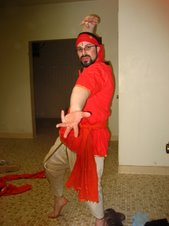The path to cheap latte and a French Cruller is paved with virulent xenophobia. As my loyal readers know, I have used this space previously to voice my disgust with the shameless xenophobia of recent Dunkin' Donuts ads. At the time, I had been unaware of the flexible immigration policies practiced by Dunkin Donuts, nor had I visited the local Dunkin Donuts franchise which was run -- shockingly enough -- by a South Asian family (again taking jobs from merit-worthy Appalachian voters!).
I suppose, bowing to the pressure I had leveled on the D-squared breakfast juggernaut, they decided to show a more cosmopolitan face in their new ads -- and what could be more cosmopolitan than Rachael Ray, in a scarf!
However, some shrewd guardians of the American lifestyle, those who had lectured us on the slippery slope of introducing Fritalian into our coffee lexicon, noticed something menacingly awry in Rachael Ray's sartorial preferences (yeah, blame the stylist -- we're not listening!) in the new spot. What's next? -- they challenged us -- Would you like your global jihad in Deici or Venti?
Yes, they noticed that behind that innocent paisley pattern, lay the sweaty, swarthy hands of the Persian Puppetmaster:
"The pattern is still widely popular in Iran. It is woven using gold or silver threads on silk or other high quality textiles for gifts, for weddings and special occasions. In Iran its use goes beyond clothing - paintings, jewelry, frescoes, curtains, tablecloths, quilts, carpets, garden landscaping, and pottery also sport the buta design."Some, though, have suggested that the black-and-white scarf pattern is not paisley at all, but rather... a Kaffiyeh...
This insidious piece of cloth, also known as the "Palestinian newsboy," as we all know, can mean anything from, "I am a Palestinian (or other Arab nationality) male" to "I am a naive and self-indulgent French teenager trying to figure out why I'm the only one of my friends who hasn't gotten laid yet." And so it was that, under pressure from alert US citizens who have led an admirable crusade against both French and Arabs alike over the past several years, Dunkin Donuts finally returned to its old ways of bashing on all things that appear foreign -- with the exception, of course, of its own latte.
Not content, however, to see Rachael Ray's accoutrement silenced, the US Department of State, amalgamating the black-and-white paisley patterned foulard with the Palestinian kaffiyeh, chose to deny the Fulbright Grant it had previously offered the scarf to complete graduate work in the United States. Although the State Department refused to shed light on any specific threat posed by the kaffiyeh-like item of apparel, they pointed to Israeli model Moran Atias' choice to exile all scarves from her own wardrobe as a model for their decision. While Ray's scarf has maintained its silence on this lost opportunity, an Israeli lawmaker has commented on the decision:
This could be interpreted as collective punishment[...] This policy is not in keeping with international standards or with the moral standards of Jews, who have been subjected to the deprivation of higher education in the past. Even in war, there are rules.This is why, in addition to maintaining my call for a boycott of You Don't Mess with the Zohan for re-invigorating the "suspect Arab" discourse within American cinema, I would like to declare June 21 "A Day Without Scarves" as a reminder that by punishing scarves for the actions of a few extremists, we just end up punishing ourselves.
What upsets me most, though, about the dual decisions of the State Department and Dunkin' Donuts, however, is their crass violation of the golden rule: Fifty million Frenchmen can't be wrong!

Now, everybody knows, when it comes to hating Arabs, the French are in a whole other league! While, here in the U.S., we have been hating Arabs off-and-on for a maximum of maybe 60 years, the French have finely tuned Arab hatred over nearly 200 years. Seriously, these guys were interning and torturing Arabs long before your average American could begin confusing Guantanamo with Guantanamera!
So why is it that the kaffiyeh is as popular among French trendsetters and youths as Cheap Trick in Japan? Based on my own unscientific and informal field surveys, more French (of non-Arab origin) youths in the all important 18-24 demo wear kaffiyehs than Palestinians. But don't trust me, see for yourself:


This is a country that tells Arab women what they can wear to school, and yet the only subject for debate among the French over wearing the kaffiyeh is whether its current standing as a fashion accessory dilutes its powerful symbolism of solidarity with the Palestinian cause.
One can only come to the conclusion that wearing the kaffiyeh is 100% compatible with defeating Islamofascism! 'Nuff said.



12 comments:
Your blog keeps getting better and better! Your older articles are not as good as newer ones you have a lot more creativity and originality now keep it up!
I wish not approve on it. I assume precise post. Particularly the title attracted me to read the intact story.
Good fill someone in on and this enter helped me alot in my college assignement. Say thank you you on your information.
Post a Comment